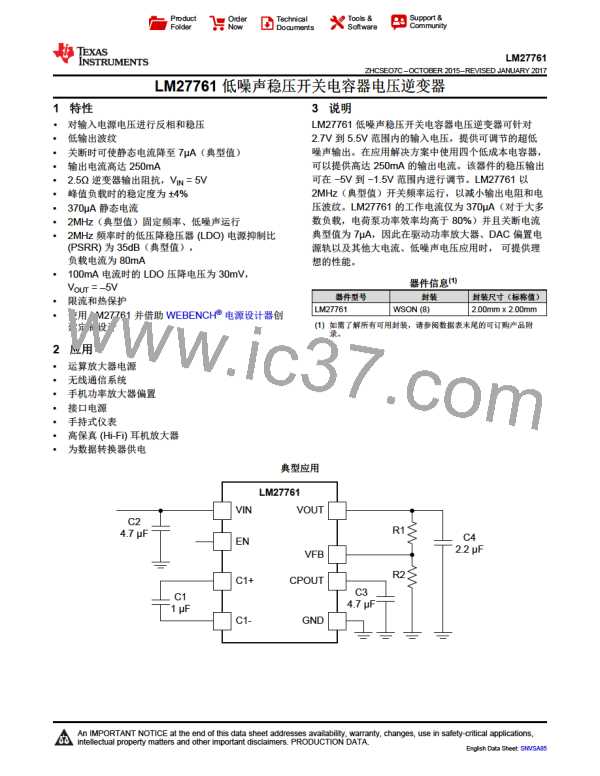LM27761
ZHCSEO7C –OCTOBER 2015–REVISED JANUARY 2017
www.ti.com.cn
7.3 Feature Description
7.3.1 Undervoltage Lockout
The LM27761 has an internal comparator that monitors the voltage at VIN and forces the device into shutdown if
the input voltage drops to 2.4 V. If the input voltage rises above 2.6 V, the LM27761 resumes normal operation.
7.3.2 Input Current Limit
The LM27761 contains current limit circuitry that protects the device in the event of excessive input current
and/or output shorts to ground. The input current is limited to 500 mA (typical) when the output is shorted directly
to ground. When the LM27761 is current limiting, power dissipation in the device is likely to be quite high. In this
event, thermal cycling is expected.
7.3.3 PFM Operation
To minimize quiescent current during light load operation, the LM27761 allows PFM or pulse-skipping operation.
By allowing the charge pump to switch less when the output current is low, the quiescent current drawn from the
power source is minimized. The frequency of pulsed operation is not limited and can drop into the sub-2-kHz
range when unloaded. As the load increases, the frequency of pulsing increases until it transitions to constant
frequency. The fundamental switching frequency in the LM27761 is 2 MHz.
7.3.4 Output Discharge
In shutdown, the LM27761 actively pulls down on the output of the device until the output voltage reaches GND.
In this mode, the current drawn from the output is approximately 1.85 mA.
7.3.5 Thermal Shutdown
The LM27761 implements a thermal shutdown mechanism to protect the device from damage due to
overheating. When the junction temperature rises to 150°C (typical), the device switches into shutdown mode.
The LM27761 releases thermal shutdown when the junction temperature is reduced to 130°C (typical).
Thermal shutdown is most often triggered by self-heating, which occurs when there is excessive power
dissipation in the device and/or insufficient thermal dissipation. The LM27761 device power dissipation increases
with increased output current and input voltage. When self-heating brings on thermal shutdown, thermal cycling
is the typical result. Thermal cycling is the repeating process where the part self-heats, enters thermal shutdown
(where internal power dissipation is practically zero), cools, turns on, and then heats up again to the thermal
shutdown threshold. Thermal cycling is recognized by a pulsing output voltage and can be stopped by reducing
the internal power dissipation (reduce input voltage and/or output current) or the ambient temperature. If thermal
cycling occurs under desired operating conditions, thermal dissipation performance must be improved to
accommodate the power dissipation of the device.
7.4 Device Functional Modes
7.4.1 Shutdown Mode
An enable pin (EN) pin is available to disable the device and place the LM27761 into shutdown mode reducing
the quiescent current to 7 µA. In shutdown, the output of the LM27761 is pulled to ground by an internal pullup
current source (approximately 1.85 mA).
7.4.2 Enable Mode
Applying a voltage greater than 1.2 V to the EN pin brings the device into enable mode. When unloaded, the
input current during operation is 370 µA. As the load current increases, so does the quiescent current. When
enabled, the output voltage is equal to the inverse of the input voltage minus the voltage drop across the charge
pump.
10
版权 © 2015–2017, Texas Instruments Incorporated

 TI [ TEXAS INSTRUMENTS ]
TI [ TEXAS INSTRUMENTS ]